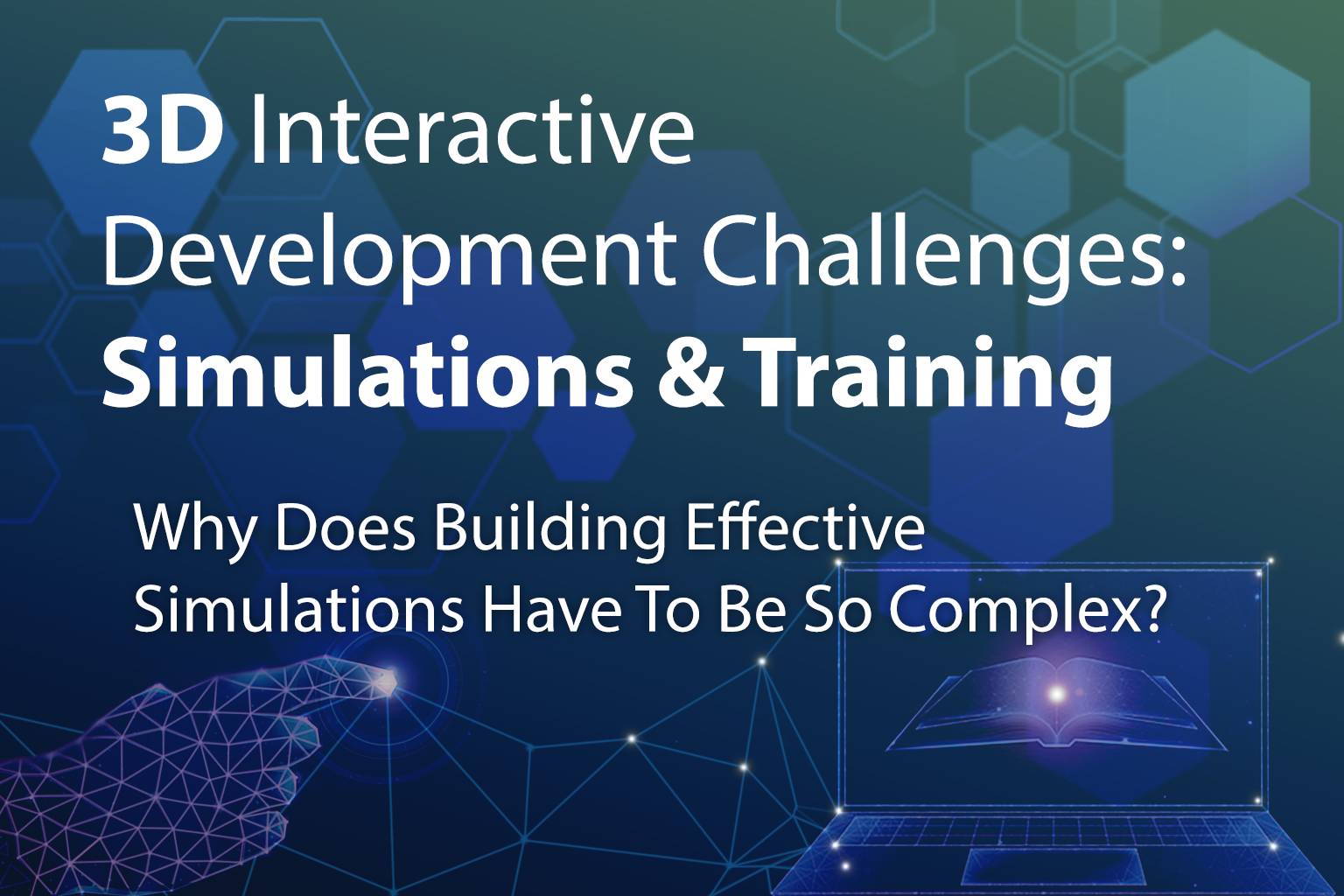𝟯𝗗 𝗜𝗻𝘁𝗲𝗿𝗮𝗰𝘁𝗶𝘃𝗲 𝗗𝗲𝘃𝗲𝗹𝗼𝗽𝗺𝗲𝗻𝘁 𝗖𝗵𝗮𝗹𝗹𝗲𝗻𝗴𝗲𝘀: 𝗦𝗶𝗺𝘂𝗹𝗮𝘁𝗶𝗼𝗻𝘀 & 𝗧𝗿𝗮𝗶𝗻𝗶𝗻𝗴
𝗪𝗵𝘆 𝗗𝗼𝗲𝘀 𝗕𝘂𝗶𝗹𝗱𝗶𝗻𝗴 𝗘𝗳𝗳𝗲𝗰𝘁𝗶𝘃𝗲 𝗦𝗶𝗺𝘂𝗹𝗮𝘁𝗶𝗼𝗻𝘀 𝗛𝗮𝘃𝗲 𝗧𝗼 𝗕𝗲 𝗦𝗼 𝗖𝗼𝗺𝗽𝗹𝗲𝘅?
 3D Simulations and interactive training programs promise faster learning, safer environments, and better decision-making. But anyone who has worked behind the scenes knows how difficult it is to deliver on that promise on the clients timeline. From the initial project setup to managing continuous updates and new iterations, simulation development introduces a unique set of challenges.
3D Simulations and interactive training programs promise faster learning, safer environments, and better decision-making. But anyone who has worked behind the scenes knows how difficult it is to deliver on that promise on the clients timeline. From the initial project setup to managing continuous updates and new iterations, simulation development introduces a unique set of challenges.
It all starts with setting up the project. Designing a simulation that accurately reflects real-world systems requires more than just technical expertise. You must gather input from subject matter experts, source accurate data, and translate complex real-world processes into interactive, functional models. Even with the best planning, you often face conflicting requirements between realism, usability, and performance.
𝙒𝙝𝙖𝙩 𝙞𝙨 𝙩𝙝𝙚 𝙢𝙤𝙨𝙩 𝙙𝙞𝙛𝙛𝙞𝙘𝙪𝙡𝙩 𝙥𝙖𝙧𝙩 𝙤𝙛 𝙨𝙚𝙩𝙩𝙞𝙣𝙜 𝙪𝙥 𝙩𝙝𝙚 𝙙𝙚𝙫𝙚𝙡𝙤𝙥𝙢𝙚𝙣𝙩 𝙚𝙣𝙫𝙞𝙧𝙤𝙣𝙢𝙚𝙣𝙩 𝙛𝙤𝙧 𝙖 𝙣𝙚𝙬 𝙨𝙞𝙢𝙪𝙡𝙖𝙩𝙞𝙤𝙣 𝙤𝙧 𝙩𝙧𝙖𝙞𝙣𝙞𝙣𝙜 𝙚𝙣𝙫𝙞𝙧𝙤𝙣𝙢𝙚𝙣𝙩?
Once development begins, the real complexity starts to set in. Every change, whether it is a new scenario, updated physics model, or user feedback adjustment, requires a new build and update to the test or production client. These updates must be tested, validated, and deployed, often across multiple environments or devices. Teams are frequently stuck waiting for the latest build to arrive before they can continue their work, which slows progress and delays delivery timelines.
𝙃𝙤𝙬 𝙙𝙤 𝙮𝙤𝙪 𝙢𝙖𝙣𝙖𝙜𝙚 𝙤𝙣𝙜𝙤𝙞𝙣𝙜 𝙪𝙥𝙙𝙖𝙩𝙚𝙨 𝙖𝙣𝙙 𝙘𝙤𝙣𝙩𝙚𝙣𝙩 𝙙𝙚𝙡𝙞𝙫𝙚𝙧𝙮 𝙙𝙪𝙧𝙞𝙣𝙜 𝙖𝙘𝙩𝙞𝙫𝙚 𝙙𝙚𝙫𝙚𝙡𝙤𝙥𝙢𝙚𝙣𝙩 𝙬𝙞𝙩𝙝𝙤𝙪𝙩 𝙨𝙩𝙖𝙡𝙡𝙞𝙣𝙜 𝙩𝙝𝙚 𝙥𝙧𝙤𝙘𝙚𝙨𝙨?
Now, there is the challenge of continuous improvement. Simulations are rarely one-and-done projects. New scenarios, updated data, and performance optimizations are constantly required to keep them relevant and effective. Each update adds to the workload and complexity, and without a streamlined deployment pipeline, managing those updates can feel overwhelming.
𝙒𝙝𝙖𝙩 𝙨𝙩𝙧𝙖𝙩𝙚𝙜𝙞𝙚𝙨 𝙤𝙧 𝙩𝙤𝙤𝙡𝙨 𝙙𝙤 𝙮𝙤𝙪 𝙪𝙨𝙚 𝙩𝙤 𝙨𝙩𝙧𝙚𝙖𝙢𝙡𝙞𝙣𝙚 𝙫𝙚𝙧𝙨𝙞𝙤𝙣 𝙘𝙤𝙣𝙩𝙧𝙤𝙡 𝙖𝙣𝙙 𝙥𝙪𝙨𝙝 𝙪𝙥𝙙𝙖𝙩𝙚𝙨 𝙚𝙛𝙛𝙞𝙘𝙞𝙚𝙣𝙩𝙡𝙮 𝙩𝙤 𝙚𝙣𝙙 𝙪𝙨𝙚𝙧𝙨?
As in our other posts, we are developing Apex Engine to directly address these challenges. Our goal is to create a unified platform that simplifies project setup, enables real-time collaboration, and streamlines the build and deployment process. Whether you are working on critical training simulations or complex interactive environments, Apex Engine is designed to help you deliver faster and more efficiently.
If you have faced similar challenges, we would love to hear about them. Share your experiences in the comments and join the conversation.
#3DDevelopment #Simulation #Training #InteractiveApplications #Collaboration #ApexEngine #RealTimeDevelopment #EducationTechnology #DefenseTraining #HealthcareSimulation #DigitalTwins #Innovation #ApexEngine #TGS #TGDSTech